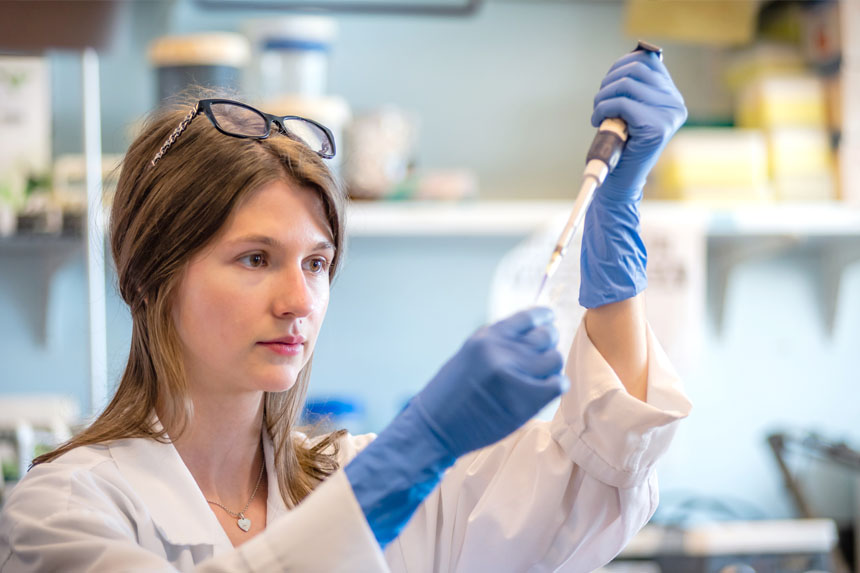Last week, I caught my first cold of the year. I cursed my luck at first (I was so convinced I’d make it through 2023 with unblemished sinuses; wildfire smoke notwithstanding). But maybe I should have been thanking my genes for having an easy go of it.
According to the Centers for Disease Control and Prevention, the average healthy adult has two or three colds each year. But for a small portion of the population with certain genes, colds are considerably more common—and even deadly.
Most people (i.e., “average healthy adults”) probably don’t ponder their genetics every time they get the sniffles. But genes can impact everything from a person’s likelihood of catching a respiratory illness, to what kind of symptoms they experience when they do, to how quickly they recover. In 2019, scientists found that “turning off” one particular gene could potentially prevent cold viruses from replicating in our bodies.
Over the last 20 years, advancements in gene therapy have changed the rules of healthcare by enabling doctors to change the genetic rules that govern our bodies. While they haven’t cracked the genetic code to end the common cold, scientists have found ways to treat other diseases at the source by adding and editing specific genes.
What is cell and gene therapy?
Gene therapy is the process of manipulating or modifying the expression of certain genes to produce a therapeutic effect. The two primary methods of gene therapy are gene addition and gene editing.
In gene addition, a doctor introduces a modified, functional gene into a patient’s stem cells to handle the work of a missing or malfunctioning gene. Gene editing uses a special protein complex to either change a mutated gene or “reprogram” a related gene to make up for the mutation.
Sometimes, gene therapy involves the transplantation of foreign stem cells into a patient’s body to introduce desirable DNA, a technique also referred to as cell therapy.
A quick history of gene therapy
While the first attempt to modify human DNA occurred in 1980, gene therapy wouldn’t receive its first official regulatory sign-off until 2003 when the Chinese State Food and Drug Administration approved Gendicine, a gene therapy medication used to treat certain head and neck cancers.
The U.S. didn’t catch up until 2017 when the Food and Drug Administration (FDA) approved tisagenlecleucel (Kymriah), a type of T-cell immunotherapy for patients with acute lymphoblastic leukemia. Over the last six years, the FDA has approved more than 30 gene therapies, and thousands of others remain in development.
What are the recent developments in gene therapy?
The rise of consumer-grade genetic testing services like 23andMe has raised the general public’s awareness of the relationship between genes and heritable conditions like cystic fibrosis, sickle cell disease, and spinal muscular atrophy—as well as their impact on relatively benign traits like caffeine sensitivity, propensity for hair loss, and even aversion to cilantro.
But the more we learn about the human genome, the more it becomes clear that genetics play a much bigger role in our overall health than we once thought.
One study of more than 15,000 pediatric ED patients found that while only about 19% of patients were known or suspected to have genetic disorders (i.e., disorders directly caused by a specific gene or chromosomal mutation), a whopping 65% had a health problem that could be associated with or potentiated by a genetic mutation.
A 2019 study from the Harvard Medical School and the University of Queensland in Australia found a genetic component in nearly 40% of common conditions ranging from upper respiratory infections to cardiovascular disease to neuromuscular disorders. Notably, the same study suggests that around 60% of monthly health spending could be predicted through genetic and environmental analysis.
Most development within the field so far has focused on severe genetic disorders—the kind for which potential parents might receive genetic testing before conceiving—but researchers are increasingly looking at gene therapy’s ability to treat more common acute and chronic conditions.
Let’s look at three areas where gene therapy is making a difference today.
Treating age-related macular degeneration with gene therapy
Gene therapy is slowly but surely becoming a more mainstream treatment regimen. For example, you might assume that loss of vision is a natural byproduct of aging, but it doesn’t have to be. Macular degeneration is influenced by more than 30 genetic factors, making it a prime target for gene therapy. In recent years, two new methods have shown particular promise for treating this condition.
In the subretinal approach, a doctor injects a gene product beneath the retina to compel retinal cells to produce a protein that inhibits the production of overexpressed growth factors associated with vascular disease. Initially brought to the market in 2017, Luxturna was the first gene replacement therapy approved by the FDA and is generally delivered through the subretinal approach.
The newer method is the suprachoroidal approach, which involves the injection of a gene therapy drug into the narrow space between the choroid (the blood vessel-filled tissue in the eye wall) and the sclera (the white of the eye). This method enables a doctor to target the retina for treatment without impacting other regions of the eye, like the lens and ciliary body. Currently undergoing phase II clinical trials, the new therapy RGX-314 can be delivered via subretinal or suprachoroidal approach to treat macular degeneration, diabetic retinopathy, and other ailments of the eye.
Neuromuscular disease and gene therapy
Neuromuscular disease is another area where gene therapy seems promising. Neuromuscular disorders cause progressive muscle weakness, fatigue, and balance and sensory issues that can eventually prevent a person from eating, drinking, or breathing on their own. It’s not difficult to see why these conditions are considered high-priority targets in the world of gene therapy.
In 2019, the FDA approved the gene therapy onasemnogene abeparvovec (Zolgensma) to treat spinal muscular atrophy. Intended for patients under two years old, Zolgensma uses a viral vector to replace the mutated gene with a healthy copy. Since it was introduced, more than 2,300 patients have been treated with Zolgensma.
Duchenne muscular dystrophy could also be on the genetic chopping block if the experimental SGT-001 gene therapy prevails, although the treatment remains in phase I and II trials for now.
The viral vectors used to deliver these therapies have also seen recent advances. Early viral vectors required massive doses to ensure therapies could impact every cell, but a 2021 study published in the New England Journal of Medicine found that genetically modified vectors could deliver their genetic payload 10 times more efficiently than unmodified versions. That means fewer side effects and better outcomes for patients receiving these treatments.
Cardiovascular disease – the next target for gene therapy
As the leading cause of death worldwide, cardiovascular disease is a white whale of biopharma and medical device developers. While the FDA has approved phase I and II trials for therapies targeting common cardiac conditions like heart failure, ischemia, and lipid imbalance, no products have been formally approved to date.
A variety of gene therapies for cardiovascular disease are actively in development. Most are designed to promote the growth of new blood vessels in the heart by increasing the expression of the vascular endothelial growth factor (the same factor that macular degeneration treatments like Luxturna aim to inhibit).
Progress could be just around the bend: Early in 2023, XyloCor Therapeutics made a major stride toward approval with the completion of phase II trials for XC001, a product intended to treat coronary artery disease and refractory angina.
What’s next for gene therapy?
Relatively speaking, gene therapy is the new kid on the biopharma block. As with any emerging technology, gene therapy will have to overcome barriers related to awareness and education to ensure that enough patients, providers, and investors are available to keep clinical trials running. And even once these therapies hit the market, developers, payors, and providers will need to work together to make them affordable—did I mention a single treatment of Zolgensma costs about $2 million?
Definitive Healthcare is keeping a close eye on this corner of the industry, and we’ve shared some insights in a variety of formats:
- Check out our report on the rise of precision medicine to learn how providers are using genetic sequencing to design highly personalized treatment plans.
- Read our blog on clinical trial volumes to learn where studies are taking place and which therapy areas are getting the most attention.
- Dig into our Healthcare Insights on hospitals using CAR-T cell therapy and other treatments for ovarian cancer.
Need an even closer look at the cell and gene therapy space? Sign up for a free trial and get access to healthcare commercial intelligence on gene therapy procedure volumes, providers performing gene therapy, and facilities where these treatments take place.




